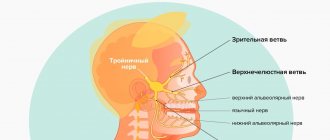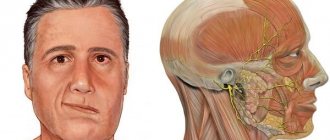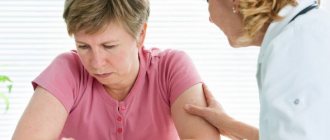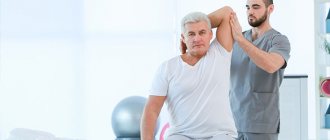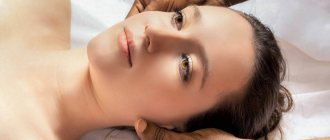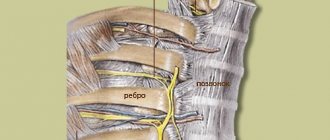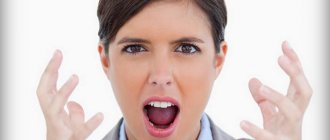Indications for massage
- Massage is indicated for almost all types of neuralgia, manifested in the following symptoms.
- Trigeminal neuralgia often occurs against the background of previous colds and inflammatory diseases or infections. It is expressed by repeated attacks of dull pain in the neck and head.
- Cutaneous neuralgia of the thigh is an unpleasant burning, stabbing pain or numbness in the outer thigh.
- Pterygopalatine neuralgia is constant severe pain in the area of the palate, temples, eyes or neck.
- Intercostal neuralgia - pain during sudden movements, coughing, sneezing.
- Occipital neuralgia is pain between the temples and the back of the head.
Treatment of neuritis
Incorrect or untimely treatment of neuritis can lead to irreversible mental disorders. Severe pain in the trigeminal nerve area prevents normal chewing of food, resulting in decreased appetite and worsening general health. Prolonged and sharp pain becomes a common cause of depression, high blood pressure, partial paralysis, etc.
Treatment is carried out both with drug therapy and massage sessions. Drug therapy uses drugs from several groups:
- antiepileptics;
- antidepressants;
- steroid painkillers;
- anti-inflammatory;
- antispasmodic and muscle relaxants.
Among the antiepileptics, Carbamazepine is often prescribed. The drug has a quick effect, but has many side effects. During use, it is necessary to constantly monitor the condition of the liver and conduct regular blood tests. Of the ointments, Viprosal quickly blocks an attack of pain, and Apizartron is prescribed to stimulate the functioning of nerve endings and increase muscle elasticity.
To reduce attacks of pain at home, you can use an alcohol infusion of lilac buds, birch buds and grated horseradish. Warm tea made from St. John's wort, mint and raspberry leaves helps relieve the condition.
Treatment of neuritis is always long-term and can take up to 10 months if the doctor’s recommendations are fully followed. In case of congenital pathology and pathology of a traumatic nature, as well as in cases where treatment has not given positive results within 10-12 months, surgical intervention is resorted to.
The effectiveness of massage
Massage for neuritis of the facial nerve allows you to restore the function of facial wrinkles. For home sessions, the patient is taught to relax muscles, which reduces pain and spasms and improves the movement of blood and lymph. A massage course for neuralgia, consisting of 20-25 sessions, allows you to:
- increase muscle tone;
- normalize the movement of biological fluids in tissues;
- improve skin condition.
The positive effect of massage on the nervous system allows the patient to relax, get rid of anxiety and nervousness, insomnia and symptoms of stress. When done correctly, the first positive changes are noticeable after just a few sessions.
Indications for massage treatment
Facial massage for facial neuritis is an important part of the complex treatment of the disease. Sessions begin 7-12 days after the first signs of neuritis appear, and the main indications for therapeutic general massage are:
- inflammatory processes of a toxic or infectious nature in the nerve;
- mechanical nerve damage;
- disruption of the facial muscles.
Supportive massage sessions are also carried out for residual effects after an illness.
For concomitant purulent diseases of the respiratory system, massage is used with caution, because active blood movement contributes to the rapid spread of infection in tissues.
Features of massage for neuralgia
- In the first days of the disease, massage is carried out in a gentle manner with a gradual increase in load in each subsequent session. Carrying out a deep massage is allowed only after the acute symptoms have subsided and the attacks of pain have subsided.
- At elevated body temperatures, massage is contraindicated.
- The effectiveness of the massage increases if it is done immediately after taking a warm shower (bath) or visiting the bathhouse. Before the massage, it is advisable to apply a warming ointment or cream to painful areas.
- It is not recommended to go out into the cold immediately after the session.
How to relieve pain
The main method of treatment is medication. Drug therapy can be supplemented with traditional medicine. In especially severe cases, it is proposed to cure the pathology through surgery.
Medicines
Ibuprofen is a pain reliever for inflammation of the trigeminal nerve.
Medicines are prescribed to eliminate unpleasant symptoms and the root cause of the disease.
Anticonvulsants relieve acute pain and dull the sensitivity of the facial nerves to external irritations.
Antispasmodic drugs relax muscles, helping to relieve a secondary pain attack. As a rule, Baclofen is used in combination with anticonvulsants: Carbamazepine, Phenytoin, Lamotrigine, Gabapeptin. In some cases, drugs in this series have side effects: dizziness, diplopia, nausea and drowsiness.
The muscle relaxants Mydocalm, Sirdalud, Baklosan and the neuroprotectors Actovegin, Cerebrolysin, Neurox are used. B vitamins Benevron BF, Neuromultivit, Milgamma are used.
Surgical intervention
The operation involves eliminating compression of the nerve trunk by a blood vessel. In some cases, surgeons resort to destruction of the trigeminal nerve or its ganglion. Manipulation allows you to relieve pain.
Surgical methods of therapy are classified as minimally invasive. These include radiosurgery. The method is a bloodless intervention that does not involve incisions or sutures.
Trigeminal nerve pain relief at home
Traditional medicine offers many recipes that can relieve unpleasant symptoms. Healing tea has become widespread. Regular consumption of the drink can reduce or relieve pain.
- Lavender. Take 100 g of plant flowers and 150 g of St. John's wort. The ingredients are mixed and 500 ml of boiling water is poured. The mixture is infused for 30 minutes. Use 200 ml warm 2 times a day until the lumbago disappears completely.
- Chamomile. Take 1 tbsp. l. dried flowers. They are brewed with 250 ml of water. Before swallowing, hold the liquid in your mouth for a few seconds.
Pain can be relieved with compresses. The main condition is the regularity of their use and the combination of such treatment with medications.
- Alteiny. Take 4 tbsp. l. plant root. They are filled with 1 glass of boiling water. The mixture is infused for 12 hours. Cotton wool or gauze is moistened with the tincture and applied to the affected area. You can wrap your face in a wool scarf. Used regularly.
- Three-component. Includes chamomile, black elderberry and lilac flowers. The ingredients are mixed in equal proportions, 500 ml of water is poured in and boiled over low heat. The broth is filtered through cheesecloth. The cake is applied in a chintz bag.
- Bolotny. Take swamp duckweed. The grass is steamed and applied through the material to the temple area. The product helps eliminate swelling in the face area.
Geranium tincture has anti-inflammatory properties
To eliminate the inflammatory process, alcohol tinctures are often used. They have a quick effect
- Geranium. The leaves of the plant and the leaves of Kalanchoe are finely chopped in a 1:1 ratio. The resulting mixture is poured into a 500 ml jar and filled with alcohol. The mixture is infused for a week in a dark place. Painful areas on the face are lubricated with the tincture.
- Birch. Take 3 tbsp. l. birch buds. They are filled with 2 glasses of vodka and infused for 2 weeks. The mixture is used as a compress.
- Raspberry. Raspberry stems and leaves are mixed in equal proportions. The mixture is soaked with 1 glass of vodka. Infuses for 9 days. Taken for 3 months, 20-40 drops before meals.
Pathology can be treated with ointments. They also have an analgesic effect.
- Lilac. Lilac leaves are boiled until the water becomes richly colored. The broth is mixed with pork fat and cooled. The ointment is rubbed into painful areas. Stored in a dark and dry place.
- Ten days. The product eliminates pain within 10 days. Take 5 g of mumiyo. The tablet dissolves in water to a pasty state. The gruel is mixed with 70 g of pork fat. Apply to the gum area closer to the cheek once a day.
Editor's note: What foods will help overcome depression?
Treatment of the trigeminal nerve is carried out comprehensively. Home therapy complements medications.
Massage techniques and methods
Techniques and methods of therapeutic massage are prescribed depending on the diagnosis made by the doctor.
Intercostal neuralgia
The patient lies on his back. At the beginning of the session, it is necessary to warm up the body - the massage therapist strokes the back with normal movements. Then more sharp stroking and kneading of the back is done from the upper to the lower part with a gradual transition to the sore areas. The latissimus dorsi muscle is affected by alternately stroking and kneading.
Massaging the ribs is carried out both on the back and in the chest area, the schemes are similar: gentle rubbing, stroking, squeezing. In order to thoroughly massage all the muscles and intercostal cavities, the massage therapist works with the pads of his fingers, directing them straight, in a circle or in a zigzag.
Chest massage includes the following techniques: rubbing, stroking, squeezing and pressing. At the end of the session, they again move on to massaging the latissimus muscle on the back using stroking, squeezing, kneading, and shaking methods.
Trigeminal neuralgia
The massage begins with alternate rubbing and stroking on the collar area, especially carefully massaging the back of the head, where many nerve endings are located. Next, proceed to facial massage. The scheme is as follows: stroking, rubbing in a circle, light kneading, vibration effects on areas with complete or partial loss of sensitivity.
Occipital neuralgia
Massage prescribed for the treatment of occipital neuralgia helps reduce pain and stop inflammation. The sequence of massage: back, neck, back of the head.
- Back. Techniques: stroking, squeezing, circular kneading of the longitudinal muscles, direct and circular kneading of the muscles located between the spine and shoulder blades.
- Neck and trapezius muscle. Techniques: stroking, squeezing, regular kneading, circular kneading with fingertips, kneading with phalanges.
- Back of the head. Techniques: regular and rake-like stroking, squeezing, straight, circular, zigzag rubbing with the pads or phalanges of four fingers.
Massage techniques
For neuritis, several massage techniques are used, as well as a set of special exercises. Regardless of the chosen technique, the main movements are performed in the directions of the massage lines. The use of amplification techniques, as well as tapping and effleurage, is prohibited.
Segmental
Carrying out segmental massage aims not only to strengthen facial muscles, but also to relieve swelling and congestion in the nerve canal, as well as improve the conductivity and excitability of nerve endings. The massage technique for neuritis includes several techniques:
- vibrating soft movements;
- light stroking massage with fingertips;
- trituration;
- stroking.
All movements of the massage therapist should be light, without pressure. If there are no concomitant inflammatory diseases, then additional use of a vibrating massager is possible.
A segmental massage session for the treatment of neuritis begins with massaging the forehead. The forehead is stroked with an open palm from the central point to the temples, after which it is carried out with light rubbing. Vertical strokes are carried out from the eyebrows to the hairline. After stroking, apply light pressure with your fingers from the central point to the temples. Then they repeat the strokes and move on to vibrational patting of the entire surface of the forehead.
After the forehead, massage the area around the eyes. Using your fingers, they pass from the outer corner of the eye along the lower edge to the inner one. Use the middle and index fingers to lightly touch the upper eyelid. Then, with pointed circular movements, massage the outer edge of the eye socket, the lower edge towards the inner corner of the eye and the area above the eyebrows.
Move on to massaging the lower jaw, nose and lips. Usually the massage begins with the healthy half of the face, and gradually moves to the affected half. Techniques for this area are carried out using the index and middle finger along lines from the middle of the chin to the wings of the nose, along the sides of the nose to the bridge of the nose, along the back of the nose to its tip. Sequence of techniques:
- horizontal rubbing;
- vertical rubbing;
- point pressure;
- light point pressure;
- stroking;
- pincer-like stroking.
Finish the session by massaging the cheeks. The entire area is stroked with the palm of the hand, then rubbed linearly. Next they do:
- circular acupressure;
- forceps massage;
- zigzag stroking;
- point pressure with fingertips;
- tingling;
- light patting;
- horizontal active stroking.
All techniques alternate with soft relaxing strokes. The use of segmental massage in the treatment of neuritis requires a gradual increase in the load on the muscles. The first introductory sessions are always carried out in a gentle mode, selecting the optimal force of influence.
Spot
Acupressure facial massage is a simple but effective technique that is also suitable for independent use. The technique uses the impact of the surface of the fingers on biologically active points on the body, which are the projection of organs and systems. For neuritis of the facial nerve, massage is performed at the following points:
- between the eyebrows. The point is massaged for several minutes for pain, fatigue, or decreased concentration;
- below the inner edge of the eyebrows. The area is massaged to relieve nasal congestion, nerve pain and improve vision;
- above the corners of the lips. The points are massaged to relieve symptoms of stress;
- on the back of the neck along the spine. Massaging the points helps eliminate the symptoms of nerve inflammation, get rid of headaches, eye pain, and migraines;
- 2 cm above the auricle. Massage of the point relieves headaches and helps with neuritis of the auricular nerve.
After the massage, it is recommended to rest for a few minutes and do 2-4 breathing exercises . Do not perform acupressure if you have high blood pressure or chronic diseases of the cardiovascular system.
Self-massage
At home, self-massage of the face is carried out using the classical method. Facial massage consists of several basic techniques:
- circling with fingertips;
- circling with fingertips;
- tingling.
All techniques are performed first on the muscles of the healthy half of the face.
The session begins with pinching at the base of the nose, gradually moving along the eyebrow line to the temples. Then pinching passes along the lower jaw from the midpoint of the chin to the bottom of the ears. Next, the face is massaged in circular movements with minimal pressure. Massage techniques affect the side of the nose, forehead, hairline area, temples, and chin. Then intense circular movements are made through the cheekbones to the temples. With slight reinforcement, they pass along the sides of the nose to the lower edge of the cheekbones and to the ears. Next, the pads of the middle fingers are pressed to the inner corners of the eyes and slowly move them towards the ears. The forehead is massaged with circular, slow and sliding movements.
Folk remedies
To relieve painful symptoms, there are proven self-medication methods:
- Black radish juice is mixed with lavender oil.
Proportions: per spoon of juice - two drops of oil. Rub the mixture over the location of the nerve. To enhance the heating, apply a woolen bandage. Use the product up to 6 times a day, for 3 days. - A boiled hot egg is peeled, cut in half and each half is applied to the affected area on the face.
- Hot salt is poured into a bag and the inflamed area is warmed up. The method relieves pain well.
- Fresh geranium leaves are applied and fixed with a bandage on the painful area. Carry out the procedure for 3-4 hours, up to two times a day.
- Aloe is good at treating inflammation. Juice, immediately after squeezing, take a teaspoon, before meals, 3-4 days.
- A compress made from marshmallow roots is considered an effective method of relieving pain. Place the crushed roots in 200 ml of boiling water and let it brew for a day. Soak a clean cloth in warm infusion and apply to the sore spot. Cover the compress with a towel and leave for an hour. After removing the lotion, wrap your face again.
- An infusion of chamomile flowers will help with neuralgia in the jaw area. Pour a teaspoon of chamomile into a glass of boiling water and let cool to room temperature. Rinse your mouth up to five times a day.
All of these remedies are suitable for home treatment, but provide only temporary relief. To eliminate the cause of inflammation, you need to consult a doctor, only he will give recommendations for effective therapy.
NTN is a fairly common disease. When treating it, you need to eliminate the cause - this is the only way to get rid of painful attacks
It is important not to delay your visit to the doctor, and then you have every chance of defeating the insidious disease
From the editor: Ways to strengthen the nervous system and psyche of a child
